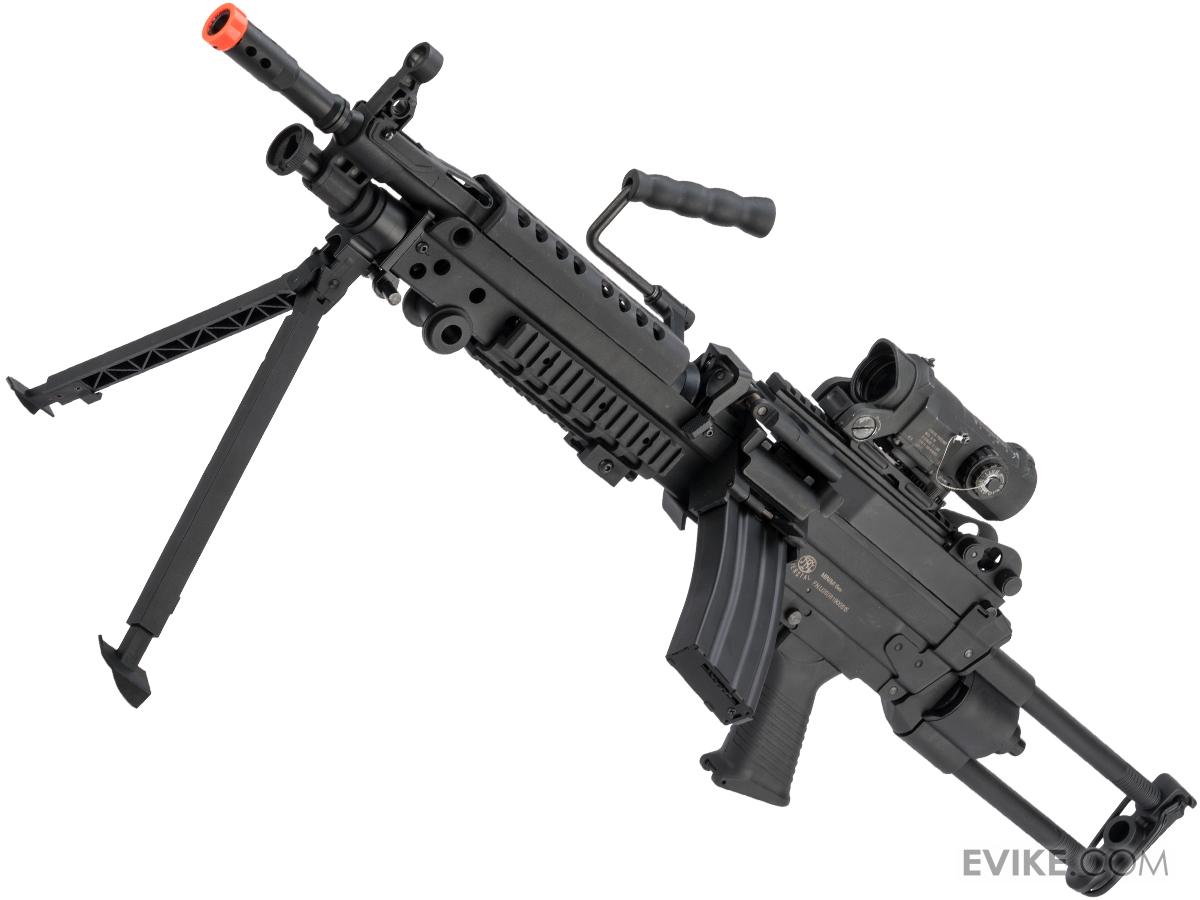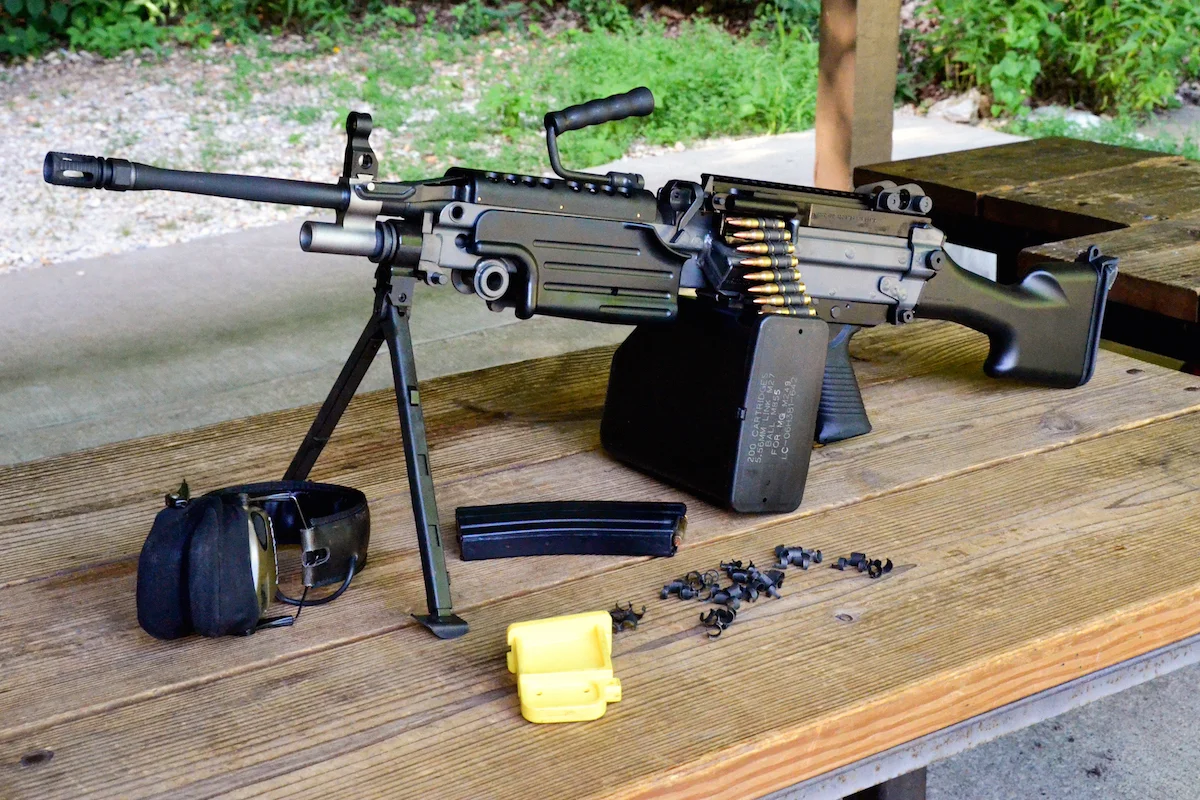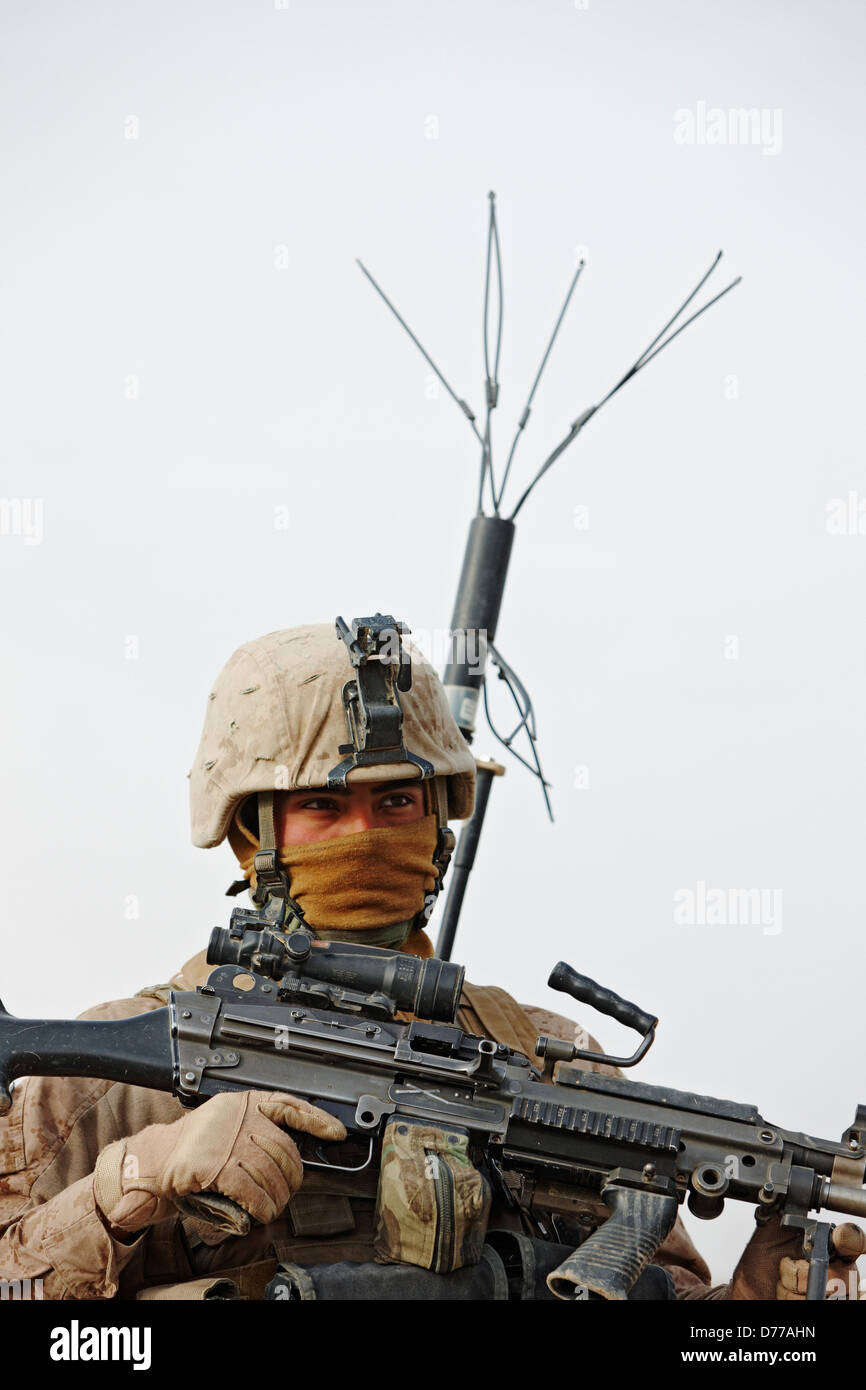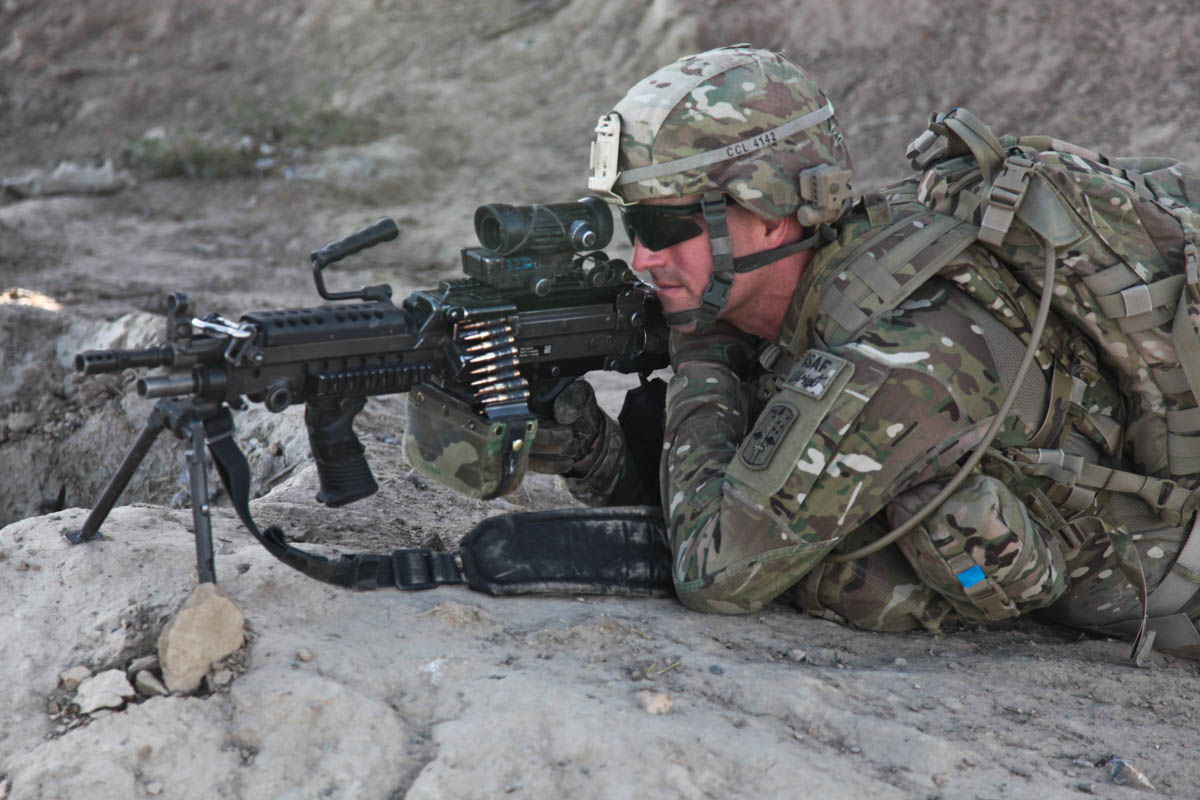M249 Saw Caliber - And officially styled the 5.56mm M249 Light Machine Gun, is an American adaptation of the Belgian FN Minimi, a light machine gun produced by the Belgian company FN Herstal (FN).
The M249 is manufactured in the United States by a subsidiary of FN Manufacturing LLC, a company in Columbia, South Carolina, and is widely used by the US Armed Forces. This weapon was introduced in 1984 after it was considered the most effective (compared to a number of candidate weapons) to address the shortage of automatic weapons in small units. The M249 offers infantry teams a high rate of fire of the machine gun combined with the accuracy and portability of the rifle.
M249 Saw Caliber
The M249 is gas-operated and air-cooled, has a quick-change barrel (allowing the shooter to quickly replace an overheated or jammed barrel), and a front-mounted folding bipod (the M192 LGM tripod is also available). The SAW can be fed from connected ammunition and from STANAG magazines (as used on the M16 and M4), allowing the SAW operator to use it as an ammunition source if he runs out of a belt. STANAG magazines should only be used in an emergency due to their high damage rate.
M249 Machine Gun On Position Isolated On White Stock Photo
The M249 has served in major conflicts involving the United States since the US invasion of Panama in 1989. In 2009, the US Marine Corps selected the M27 Infantry Automatic Rifle to partially replace the M249 in USMC service.
In 1965, the primary machine guns of the US Army and US Marine Corps were the M2 Browning and the M60. The M2 is a large-caliber heavy machine gun, usually mounted or fixed on a vehicle.
The M60 is a more mobile multipurpose machine gun intended to be carried by troops to provide heavy automatic fire.
Both firearms are very heavy and usually require at least a crew of two to operate effectively.
M249 Light Machine Gun Hi Res Stock Photography And Images
The Browning Automatic Rifle (BAR), the Army's primary individual machine gun since its introduction in World War I, was phased out in 1957 with the introduction of the M14 rifle (which had a fully automatic mode).
The "designated rifles" in each squad are trained to use their weapons on full auto, while the other squads are required to use their rifles on semi-auto most of the time to improve accuracy and conserve ammunition .
Because the M14 and M16 rifles were not designed for continuous automatic fire, they often overheated or jammed.

The 20- and 30-round magazines of these weapons limit their continuous automatic effectiveness compared to belt-fed weapons.
Fn M249s Saw 5.56mm Belt Fed
The Army decided that a single machine gun, lighter than the M60 but with more firepower than the M16, would be advantageous; Troops no longer have to rely on rifles for automatic fire.
Throughout the 1960s, the introduction of the machine gun to the infantry was examined in various studies.
While there was a brief flirtation with the concept of universal flechette or arrow machine guns during one study, most experiments with light machine guns focused on the Stoner 63 light machine gun, a modular weapon that could be easily modified for different purposes.
The Stoner 63 LMG saw brief combat in Vietnam with the Marine Corps, and then on a larger scale with the US Navy SEALs.
A&k Full Metal M249 Airsoft Machine Gun (version: Para / Black / Aeg)
In 1968, the Army Small Arms Program developed plans for a new 5.56 mm LMG, although no funds were allocated (5.56 mm ammunition was considered insufficient by many armed forces). Studies are being initiated to upgrade the 5.56mm ammunition with better performance characteristics.
In July 1970, the US Army finally approved the development of the LMG, without a specific caliber. At this time, the "Squad Automatic Weapon" (SAW) designation was introduced.
Current alternative cartridge designs for the new LMG began in July 1971. A month later, Frankford Arsal decided on two cartridge designs for the new LMG: the 6mm cartridge and the new 5.56mm cartridge in a much bigger.

Neither design was finalized until March 1972, when the Army published specification documents for the proposed SAW.
Bullets Gun Vector Stock Illustrations
Prior to July 1972, SAW development contracts were awarded to Maremont, Philco Ford and Rodman Laboratories on Rock Island Arsal. These companies produced models with the Army designations XM233, XM234 and XM235 respectively – the X standing for "experimental". The design was to weigh less than 9.07 kg (20 lb), including 200 rounds of ammunition, and a minimum range of 800 meters (2,600 ft).
An early Minimi prototype designed in Belgium was sent to the US Infantry Board for evaluation, before being designated the XM249
When it came time for development and operational testing of the SAW candidate, three candidate 5.56mm guns were included with the 6mm candidate: the M16 HBAR, a heavy barrel variant of the M16 designed for extended firing; Minimi Fabrique Nationale de Herstal (FN); and HK 23A1. The initial round of tests ended in December 1974.
In February 1976, the Minimi and Rodman XM235 SAWs were selected for further development. By this time, opinion of the 6mm cartridge had begun to sour due to the logistical implications of supplying the infantry with other types of ammunition.
M249 Machine Gun Case
In June, the SAW specification document called for revisions to emphasize standard 5.56mm ammunition. In October the requested revisions were approved and bids submitted for the Rodman XM235 conversion to 5.56mm. Production of the converted XM235 was assigned to Ford Aerospace and its designation was changed to XM248.
A new M16 HBAR variant, the XM106, was developed in 1978, and shortly thereafter Heckler & Koch lobbied to include a 5.56mm conversion of the HK 21A1 (instead of the standard 7.62mm NATO was producing) in future SAW tests. The latest model is called XM262. Currently, the Minimi receives the designation XM249.
In May 1980, the FN XM249 was voted the top choice for future development based on performance and cost, with the HK XM262 rumored to be a close second.

The new weapon ends the service of the US military. as the M249 squad automatic weapon in 1984 and was adopted by the US Marine Corps. one year later. The US production model has a different bottom than the regular Minimi.
The U.s. Military Is Doubling Down On The 'super Saw' Machine Gun
Although proven to be reliable and accurate, the M249 was considered an unacceptable hazard by its hot open barrel and sharp tip. There are complaints that the viewfinder requires a special adjustment tool. On August 23, 1985, USA. Under Secretary of the Army James R. Ambrose suspended production of the M249 due to the development of a product improvement program (PIP) intended to address this problem.
Congress eliminated funding for the M249 from the FY 1986 defense budget, retroactively withdrawing prior-year program funds from the M249 program for other purposes, including pensions and pay increases. The more than 1,100 M249s that were issued will remain in service but will be fitted with PIP kits as they become available. The remaining 7,000 M249s will remain in storage until corrective modifications can be made. The PIP kit was eventually developed and implemented, and production of the M249 resumed.
It fires the 5.56×45mm NATO cartridge, usually a combination of one M856 tracer and four M855 ball cartridges fed from the belt-linked M27. The belt is usually stored in a hard plastic or soft cloth case that fits under the gun.
It fires from the operational bolt and is gas operated. When the trigger is pulled, the bolt and bolt carrier move forward under the force of the recoil spring. The cartridge is removed from the belt, chambered and ejected, firing a bullet into the bore. The expanding propellant gases are diverted through an opening in the barrel into a chamber. This pressure drives a piston that provides energy to extract and eject the case, as well as advance the belt and compress the recoil spring, thus preparing for the next shot. At 1,041 mm (41 in) long and 7.5 kg (17 lb) (10 kg (22 lb) including the 200-round belt and plastic ammunition box), the M249 was a heavy weapon.
Maintaining The M249 Saw Ssg Garcia.
The M249's air-cooled barrel is equipped with a mechanism to remove and replace the barrel assembly with a spare, this allows the operator to easily replace the barrel in the field if the barrel becomes too hot during a large number of fires. The barrel has a crushing capacity of one revolution in 180 mm (7 inches).
A folding bipod with adjustable legs mounts near the front of the weapon, although provision is made for hard mounting on an M192 Lightweight Ground Mount tripod or vehicle mount.
The original M249 gas regulator has two different sizes of gas ports, normal and reverse. The adverse setting increased the cyclic rate of fire from 700–850 rounds per minute to 950–1,150 rounds per minute and was used only in extreme environmental conditions or when heavy dirt persisted in the gun's gas cylinders. The two-position gas regulator was removed as part of the product upgrade program, which prevented M249s that received product upgrade kits from firing at a higher cycle rate.

Sustained rate of fire, the pace at which
Fn M249s 5.56mm Nato 18.5in Black Semi Automatic Rifle
M249 caliber, nerf m249 saw, m249 saw replacement, m249 saw rate of fire, m249 saw, m249 saw accessories, m249 saw sling, toy m249 saw, m1 caliber miter saw, fn saw m249, m249 saw barrel, m249 saw pouches
0 Comments